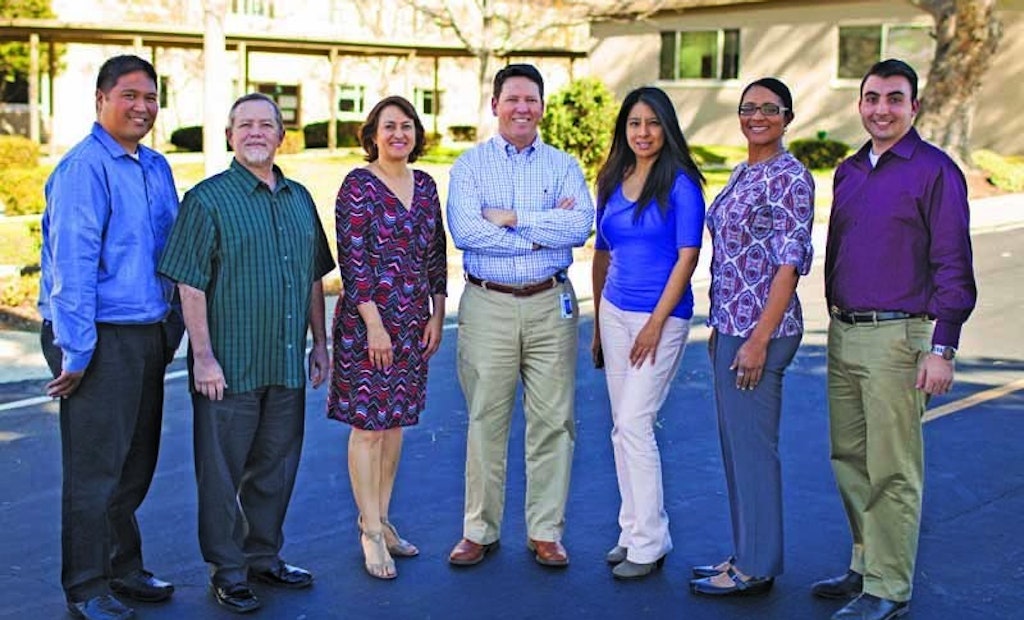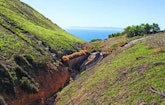
Interested in Infrastructure?
Get Infrastructure articles, news and videos right in your inbox! Sign up now.
Infrastructure + Get AlertsImagine a winding, switch-backed highway, running along a picturesque canyon down to a bluff overlooking the Pacific Ocean.
Now picture a major rainstorm creating landslides along the canyon wall, soil and debris piling up in the canyon bottom, and water overflowing and taking out whole sections of the roadway, destroying access to critical neighborhoods and government facilities.
That’s the scenario that prompted the Department of Public Works in Rancho Palos Verdes, California, to spearhead an award-winning project that now protects the San Ramon Canyon by diverting storm flow into a series of pipes that discharge through a new outfall structure into the ocean. At the same time, the project has restored the canyon’s original bottom elevation and rebuilt portions of the roadway.
“Planners told us that if we did nothing, it was probably five to seven years before the roadway might have collapsed,” says Andy Winje, senior engineer with the Rancho Palos Verdes DPW. “And it could not have been rebuilt if that had happened.”
The project called for tunnels through unstable soil, featured a crane that lowered workers and materials over the bluff bank, and an ocean outfall sculpted and colored to match the bluff. In addition, the project was completed under budget and was executed with minimal traffic disruption.
Harris & Associates of Irvine, California, was the design engineer; L.H. Woods, Vista, California, the general contractor; and KOA Corporation, Monterey Park, California, the construction manager. Northwest Pipe Co. of Vancouver, Washington, provided the pipe.
Critical roadways
The roads in question are Palos Verdes Drive East, with twisty hairpin turns winding along the canyon rim, and Palos Verdes Drive South, a main highway along the coast. In the past, stormwater traveled down the canyon, accumulating debris from the unstable “landslide” soil lining its banks. Debris would pile up at a culvert under Palos Verdes Drive South, flooding the road. At the same time, the rushing water had scoured the canyon floor 30 to 40 feet below its historic levels and eroded the canyon wall supporting Palos Verdes Drive East.
“The culvert was pretty undersized,” explains Winje. “Mud and rocks would block it and the detention area behind it would fill and overflow.” In the meantime, the landslide area along the canyon wall was slowly moving from east to west, pushing the streambed farther west and aggravating the erosion problems.
Big storms in 2010 brought the issue into focus, and this small but affluent community of 43,000 began to think seriously about the impact of losing both roads. The loss would cut off transportation to the beach and resort area, seriously impact commutes, and restrict access to two critical government facilities — an air traffic control center and a U.S. Coast Guard installation.
“That storm was our motivation,” Winje says.
The fix presented a number of challenges, including financing, soil conditions, and design and construction of a new outlet structure on the beach, but all were solvable.
At a projected cost of $19 million, the San Ramon Canyon storm drain project was the biggest the city has ever tackled from a financial standpoint. In fact, Winje points out, the cost nearly equaled the city’s entire operating budget for a full year. The solution lay in securing a $9.5 million reimbursement grant from the state’s Department of Water Resources and paying the balance out of the city’s cash reserve. No debt was incurred.
Hard work and creativity
The engineering and construction of the project required even more thought and hard work. The planning and design phase took about a year, and ground was broken in April 2013, with work commencing on a pair of tunnels housing a 54-inch-diameter steel pipe with welded joints.
“The pipe within the tunnels carries the diverted flow from the creek bed to the ocean, while avoiding the landslide-prone canyon walls,” Winje explains.
One tunnel extends 2,000 feet from the inlet at the bottom of the canyon and under two major roads. It is of rib and lag construction, 80 inches in diameter. Drill Tech of Antioch, California, dug the tunnel from the downhill side using an excavator mounted on a small rail track and equipped with a shield to prevent rock and soil damage from above. Spoils were taken out on carts using a small diesel locomotive and disposed of on nearby land or trucked away.
Winje says soil conditions presented unusual issues. “The tunnel went through soil structure formed by landslides that had occurred in the past — known as ‘dormant’ landslides. The soil layers are unconsolidated or jumbled up with no consistent geologic structure,” he explains. “We weren’t sure what we’d find.”
A second tunnel — also dug by Drill Tech using conventional jack and sleeve methods — carried another section of the steel pipe from the bluff some 300 feet down to the base of the bluff at the beach. In between, a 1,700-foot trench was open cut to carry pipe across flatter and more stable land from Palos Verdes Drive South to the edge of the bluff, connecting the sections in the two tunnels.
Annular space between tunnel walls and the outside pipe surface was grouted in.
The tunnels took about four months to complete, and were finished on time and within budget.
The new outfall structure on the beach required an even more creative approach. Winje says original plans called for a conventional concrete structure anchored to the beach by deep caissons. But the construction team came up with an alternative.
Instead of being mounted on caissons, which would have required large excavations, the structure is pinned to the side of the bluff using soil nails inserted into the bluff to anchor the outlet structure.
Workers and materials were lowered from the top of the bluff to the construction site 100 feet below via a large crane positioned topside. This avoided dragging equipment and materials from the nearest vehicle access over a 3/4-mile stretch of rocky shoreline, subject to winter storms.
In addition, the structure was “sculpted” by Drill Tech’s crews so that its surface blends with the bluff. The concrete was also colored to further integrate the structure into its environment. “This is a very pristine area and we did not want the outfall to be an eyesore,” Winje says. “It was a feel-good thing for us to do and it actually saved money for the project.”
Other features
The inlet structure, located at the midpoint of the canyon, was more traditionally built. Caissons were sunk into the bottom of the canyon, and the concrete structure installed on top of them. The function of the inlet is to divert flow away from the canyon creek bed and into the pipe. Winje explains that in extreme conditions, overflow from the inlet can be directed down the creek.
The improvements effectively prevent mud sprays from coating nearby houses. The sprays were created when muddy stormwater exited the old storm drain outlet at the top of the bluff, and the wind sometimes carried the spray into the neighborhood. Now, of course, the muddy water is directed into the new pipe system and discharged at sea level, well below the homes.
The final feature of the project involved land restoration. Winje explains that the scouring of the canyon floor had created a 30-foot-deep gorge that was “pretty sterile” — absent of any vegetation. “Nothing grew down there,” he says.
The gorge was filled in to the historical height of the creek bed, and reinforced with riprap. Then, the area was landscaped with native plantings.
The restoration has allowed traditional hiking paths to be restored along the canyon banks and across the creek bed. “We’ve been able to reconnect the trail system,” says Winje, noting the area is now used by hikers and mountain bikers.
While the project promises to benefit the area for decades to come, there was plenty of concern at the beginning, mostly because of the exceptional cost. “It was discussed openly at council meetings and publicized in the city newsletter,” Winje says.
The reimbursement grant was good news, and the fact that traffic interruptions on the affected roadways were kept to a minimum and lasted for only a few minutes also helped dampen any criticism. Now, especially in an El Niño year, the residents and city leaders feel protected.
People are curious about the results. “We haven’t had a huge storm yet, but we’ve had some significant rains recently and the detention area (which used to back up) has remained dry,” Winje reports. “After storms, people ask us, ‘Is it working?’”
So far, the answer is “absolutely.”
Engineered Savings
The San Ramon Canyon storm drain project not only saved the canyon walls and the roadway above it, it saved money that was then used to fund other improvements.
Senior engineer Andy Winje explains that the team conducted a value engineering exercise at the beginning of the project. One of the outcomes was a change in the methodology used to install the 54-inch steel pipe. The specifications called for a proprietary joint system, believing welded joints would be too difficult to construct at the pipe’s steep slopes. But the installation contractor suggested they could be welded in the traditional fashion, and they were. Money saved was shared between the city and the contractor.
Likewise, savings accrued from changes in the design and installation method of the outlet structure were shared with the contractor.
“With the extra money available, we had funds to spend on related projects,” Winje says. “We used the money to repair storm drains as well as asphalt damaged during the canyon reconstruction. We were also able to fund some additional storm drain improvements on Palos Verdes Drive East, and rehabilitate some of the culverts with the blessing of the state grant administrators.
“It was a way to get more bang for the buck.”









